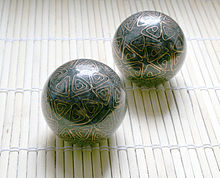Qigong balls
Qigongkugeln (also Chi-Gong balls , Qi Gong balls or short Qi-balls called) or Baodingkugeln ( Chinese 健身球 , Pinyin jianshenqiu - "balls for strengthening of health"), German also sound ball , exercise ball or relaxation ball called, are essentially enameled metal balls. They produce a pleasant sound when shaken. The name Qigong is composed of the word Qi , the life energy, the circulation of which in the body can be equated with health, and the word gong , which describes a technique for cultivating this personal life energy.
A set, usually with a storage box, consists of two spheres with different sounds. Two inner spheres generate a high tone, which symbolizes the feminine ( Yin ), and a low tone, which symbolizes the masculine ( Yang ). Originally, these sounds were also called phoenix or dragon calls.
The Qigong balls are called Baoding balls if they were made in the city of Baoding in the Chinese province of Hebei .
construction
The outer layer usually consists of colored enamel . The diameter is usually 40 to 45 mm. The smallest, which can be used sensibly in the sense of QiGong, are 30 mm in size, the largest up to 80 mm. Most designs are hollow and have sound elements built into them. Under the enamel layer there is a hollow steel ball in which the sound mechanism is incorporated. Usually the sound-producing element is a spring made of wire or sheet metal, which is excited by a small glass ball inside the hollow ball.
history
The use of Qigong balls goes back to the Ming Dynasty (China). At first, the balls were just plain walnuts , chestnuts or the like to stimulate dexterity. Over the centuries, they became stone, clay or metal balls (since the 14th century) through to small works of art with elaborate, sounding inner workings. Since the 18th century, artistic decorations can also be found on the surfaces of the small spheres.
Application and use
According to Chinese tradition, the balls are supposed to restore the balance of yin and yang in your own body. In addition, the reflex zones of the hand should be stimulated.
There are various exercises that can vary according to the number of balls and the skill of the practitioner. In these exercises, a distinction can be made between turning (movement of the balls without touching one another), pushing (movement with the balls rubbing against each other) and rolling (movement of only one ball on the hand).
Traditionally, different acupuncture points should be activated on the hand. Blockages in the Qi flow of the body should be released and thus also have a supportive effect on the improvement of chronic diseases. According to Chinese tradition, learning how to turn the ball achieves harmonization of the body. At the same time, this should also expand the individual's possibilities for spiritual development.
The coordinative skills are trained by moving the balls in the hand. It is also intended to stimulate acupuncture points in the hands. Together with the pleasant sound, this can lead to stress relief and relaxation. Sound balls are also used in hearing training for hearing- impaired toddlers.
Sound balls are popular souvenirs on trips to Asia and are also suitable as children's toys .
literature
- Dorothea Quella Hermann: Approaching the Qi Gong balls. Neuromedizin-Verlag, Bad Hersfeld 1996, ISBN 3-930926-04-0 .
- Hans Höting: Qi-gong balls for health, meditation and vitality. 3rd edition, Hugendubel, Munich 1994, ISBN 3-88034-711-5 .
- Ernst Paulus, Ding Yuhe: Chinese health balls keep you young and vital. Kai Yeh Verlag, Cologne 1988, ISBN 3-923131-30-5 .
- Richard Weigerstorfer: Qi-Gong balls - the effects and many exercises. 9th edition. RiWei-Verlag, Regensburg 2005, ISBN 978-3-89758-226-2 .
Web links
Individual evidence
- ↑ Practical ball exercises (pictorial representation of a possible game variant) ( Memento from February 3, 2010 in the Internet Archive )
- ↑ Monika M. Thiel: Speech therapy for children's hearing disorders . Springer, Berlin 2000, ISBN 3-540-66515-3 , pp. 149 ff. ( Limited preview in the Google book search).
- ^ Norbert Rath: The school kindergarten . Waxmann, Berlin 2001, ISBN 3-89325-830-2 , p. 126 ( limited preview in the Google book search).


